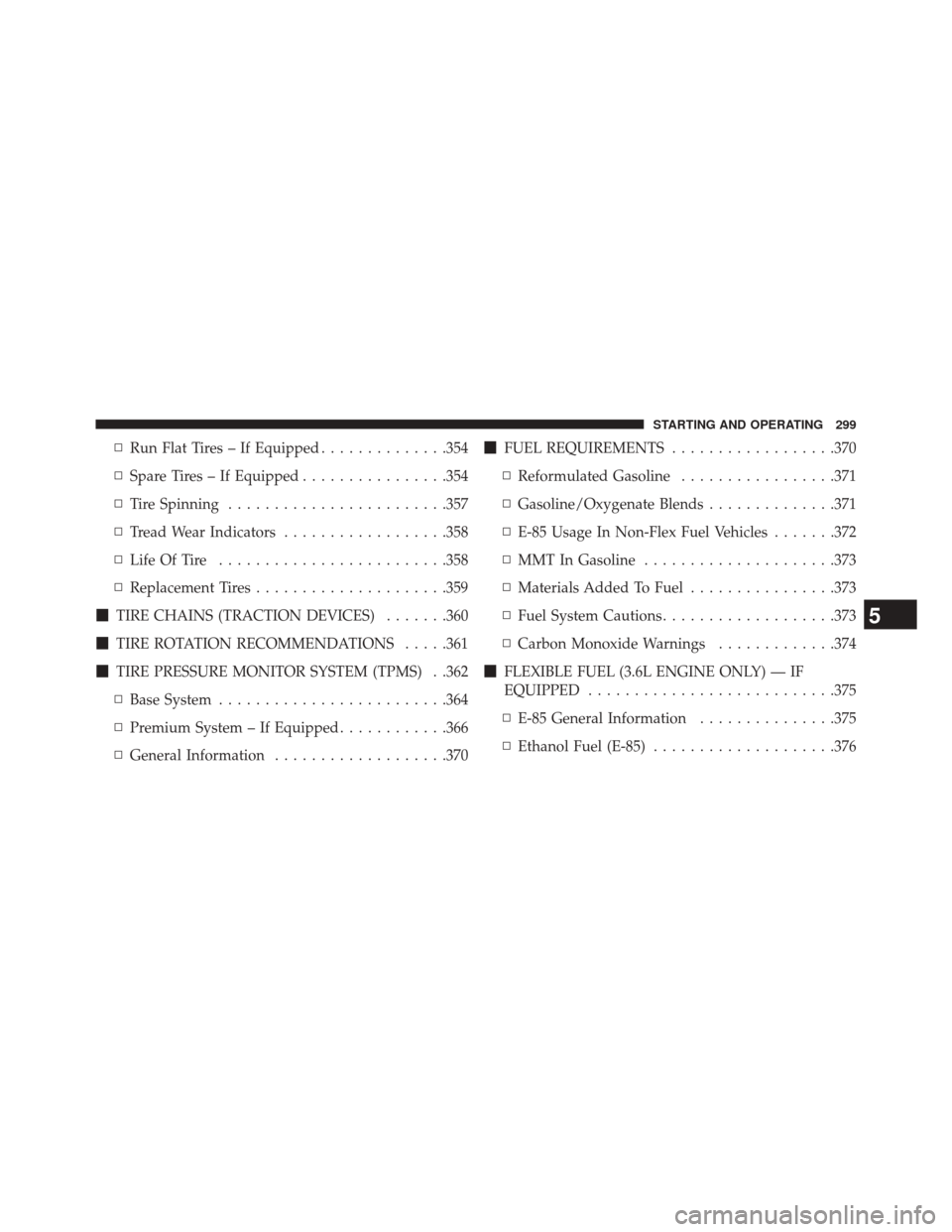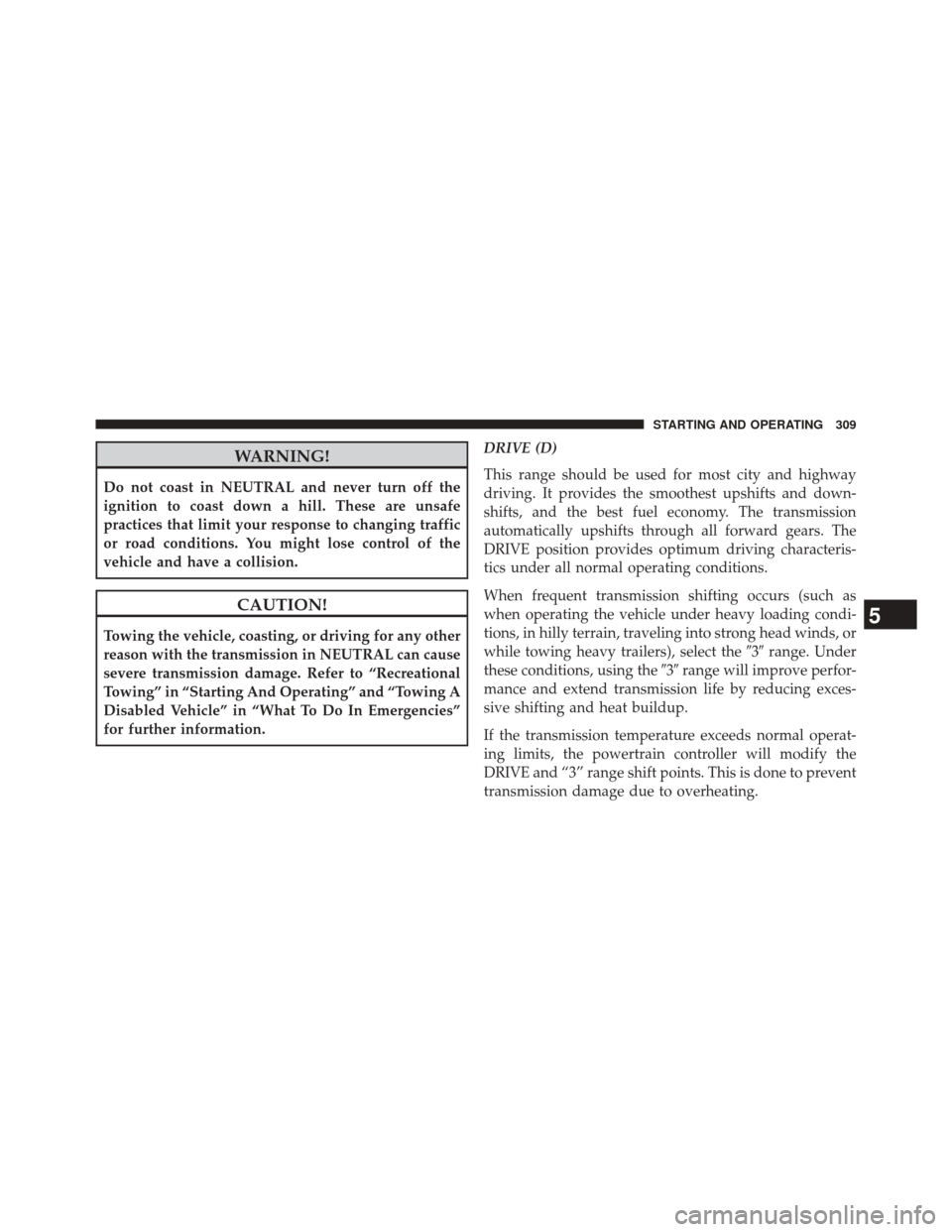Page 301 of 522

▫Run Flat Tires – If Equipped ..............354
▫ Spare Tires – If Equipped ................354
▫ Tire Spinning ....................... .357
▫ Tread Wear Indicators ..................358
▫ Life Of Tire ........................ .358
▫ Replacement Tires .....................359
� TIRE CHAINS (TRACTION DEVICES) .......360
� TIRE ROTATION RECOMMENDATIONS .....361
� TIRE PRESSURE MONITOR SYSTEM (TPMS) . .362
▫ Base System ........................ .364
▫ Premium System – If Equipped ............366
▫ General Information ...................370 �
FUEL REQUIREMENTS ..................370
▫ Reformulated Gasoline .................371
▫ Gasoline/Oxygenate Blends ..............371
▫ E-85 Usage In Non-Flex Fuel Vehicles .......372
▫ MMT In Gasoline .....................373
▫ Materials Added To Fuel ................373
▫ Fuel System Cautions ...................373
▫ Carbon Monoxide Warnings .............374
� FLEXIBLE FUEL (3.6L ENGINE ONLY) — IF
EQUIPPED .......................... .375
▫ E-85 General Information ...............375
▫ Ethanol Fuel (E-85) ....................376
5
STARTING AND OPERATING 299
Page 302 of 522

▫Fuel Requirements ....................376
▫ Selection Of Engine Oil For Flexible Fuel Vehicles
(E-85) And Gasoline Vehicles .............377
▫ Starting ........................... .378
▫ Cruising Range ...................... .378
▫ Replacement Parts ....................378
▫ Maintenance ....................... .378
� ADDING FUEL ....................... .379
▫ Fuel Filler Cap (Gas Cap) ...............379
▫ Loose Filler Cap Message ...............381
� VEHICLE LOADING ....................382
▫ Vehicle Certification Label ...............382 ▫
Gross Vehicle Weight Rating (GVWR) .......382
▫ Gross Axle Weight Rating (GAWR) .........382
▫ Overloading ........................ .383
▫ Loading ........................... .383
� TRAILER TOWING .....................384
▫ Common Towing Definitions .............384
� RECREATIONAL TOWING (BEHIND
MOTORHOME, ETC.) ...................395
▫ Towing This Vehicle Behind Another Vehicle . .395
▫ Recreational Towing – All Models ..........395
300 STARTING AND OPERATING
Page 311 of 522

WARNING!
Do not coast in NEUTRAL and never turn off the
ignition to coast down a hill. These are unsafe
practices that limit your response to changing traffic
or road conditions. You might lose control of the
vehicle and have a collision.
CAUTION!
Towing the vehicle, coasting, or driving for any other
reason with the transmission in NEUTRAL can cause
severe transmission damage. Refer to “Recreational
Towing” in “Starting And Operating” and “Towing A
Disabled Vehicle” in “What To Do In Emergencies”
for further information.DRIVE (D)
This range should be used for most city and highway
driving. It provides the smoothest upshifts and down-
shifts, and the best fuel economy. The transmission
automatically upshifts through all forward gears. The
DRIVE position provides optimum driving characteris-
tics under all normal operating conditions.
When frequent transmission shifting occurs (such as
when operating the vehicle under heavy loading condi-
tions, in hilly terrain, traveling into strong head winds, or
while towing heavy trailers), select the
�3�range. Under
these conditions, using the �3�range will improve perfor-
mance and extend transmission life by reducing exces-
sive shifting and heat buildup.
If the transmission temperature exceeds normal operat-
ing limits, the powertrain controller will modify the
DRIVE and “3” range shift points. This is done to prevent
transmission damage due to overheating.
5
STARTING AND OPERATING 309
Page 314 of 522

•the engine coolant has reached an adequate tempera-
ture,
• vehicle speed is sufficiently high, and
• the driver is not heavily pressing the accelerator.
Torque Converter Clutch
A feature designed to improve fuel economy has been
included in the automatic transmission on your vehicle.
A clutch within the torque converter engages automati-
cally at calibrated speeds. This may result in a slightly
different feeling or response during normal operation in
the upper gears. When the vehicle speed drops or during
some accelerations, the clutch automatically disengages.
NOTE: The torque converter clutch will not engage until
the transmission fluid and engine coolant are warm
[usually after 1 to 3 miles (2 to 5 km) of driving]. Because
the engine speed is higher when the torque converter
clutch is not engaged, it may seem as if the transmission is not shifting into Overdrive when cold. This is normal.
Shifting between the DRIVE and 3 ranges, when the
transmission is sufficiently warm, will demonstrate that
the transmission is able to shift into and out of Overdrive.
Six-Speed Automatic Transmission – If Equipped
The transmission gear position display (located in the
instrument cluster) indicates the transmission gear range.
You must press the brake pedal to move the shift lever
out of PARK (refer to “Brake/Transmission Shift Inter-
lock System” in this section). To drive, move the shift
lever from PARK or NEUTRAL to the DRIVE position.
The electronically-controlled transmission provides a
precise shift schedule. The transmission electronics are
self-calibrating; therefore, the first few shifts on a new
vehicle may be somewhat abrupt. This is a normal
condition, and precision shifts will develop within a few
hundred miles (kilometers).
312 STARTING AND OPERATING
Page 319 of 522

WARNING!
Do not coast in NEUTRAL and never turn off the
ignition to coast down a hill. These are unsafe
practices that limit your response to changing traffic
or road conditions. You might lose control of the
vehicle and have a collision.
CAUTION!
Towing the vehicle, coasting, or driving for any other
reason with the transmission in NEUTRAL can cause
severe transmission damage. Refer to “Recreational
Towing” in “Starting And Operating” and “Towing A
Disabled Vehicle” in “What To Do In Emergencies”
for further information.DRIVE (D)
This range should be used for most city and highway
driving. It provides the smoothest upshifts and down-
shifts, and the best fuel economy. The transmission
automatically upshifts through underdrive first, second,
third, and fourth gears, direct fifth gear and overdrive
sixth gear. The DRIVE position provides optimum driv-
ing characteristics under all normal operating conditions.
When frequent transmission shifting occurs (such as
when operating the vehicle under heavy loading condi-
tions, in hilly terrain, traveling into strong head winds, or
while towing heavy trailers), use the AutoStick® shift
control (refer to “AutoStick®” in this section for further
information) to select a lower gear. Under these condi-
tions, using a lower gear will improve performance and
extend transmission life by reducing excessive shifting
and heat buildup.
5
STARTING AND OPERATING 317
Page 321 of 522

NOTE:Even if the transmission can be reset, we recom-
mend that you visit your authorized dealer at your
earliest possible convenience. Your authorized dealer has
diagnostic equipment to determine if the problem could
recur.
If the transmission cannot be reset, authorized dealer
service is required.
Overdrive Operation
The automatic transmission includes an electronically
controlled Overdrive (sixth gear). The transmission will
automatically shift into Overdrive if the following con-
ditions are present:
• The shift lever is in the DRIVE position.
• The transmission fluid has reached an adequate tem-
perature. •
The engine coolant has reached an adequate tempera-
ture.
• The vehicle speed is sufficiently high.
• The driver is not heavily pressing the accelerator.
Torque Converter Clutch
A feature designed to improve fuel economy has been
included in the automatic transmission on your vehicle.
A clutch within the torque converter engages automati-
cally at calibrated speeds. This may result in a slightly
different feeling or response during normal operation in
the upper gears. When the vehicle speed drops or during
some accelerations, the clutch automatically disengages.
NOTE: The torque converter clutch will not engage until
the transmission fluid and engine coolant are warm
(usually after 1 to 3 miles [2 to 5 km] of driving). Because
the engine speed is higher when the torque converter
clutch is not engaged, it may seem as if the transmission
5
STARTING AND OPERATING 319
Page 352 of 522

WARNING!(Continued)
•Unequal tire pressures from one side of the vehicle
to the other can cause the vehicle to drift to the
right or left.
• Always drive with each tire inflated to the recom-
mended cold tire inflation pressure.
Economy
Improper inflation pressures can cause uneven wear
patterns to develop across the tire tread. These abnormal
wear patterns will reduce tread life resulting in a need for
earlier tire replacement. Under-inflation also increases
tire rolling resistance resulting in higher fuel consump-
tion.
Ride Comfort And Vehicle Stability
Proper tire inflation contributes to a comfortable ride.
Over-inflation produces a jarring and uncomfortable
ride. Both under-inflation and over-inflation affect the stability of the vehicle and can produce a feeling of
sluggish response or over responsiveness in the steering.
NOTE:
•
Unequal tire pressures from side to side may cause
erratic and unpredictable steering response.
• Unequal tire pressure from side to side may cause the
vehicle to drift left or right.
Tire Inflation Pressures
The proper cold tire inflation pressure is listed on the
driver’s side “B” Pillar or rear edge of the driver’s side
door.
At least once a month:
• Check and adjust tire pressure with a good quality
pocket-type pressure gauge. Do not make a visual
350 STARTING AND OPERATING
Page 366 of 522

NOTE:
•The TPMS is not intended to replace normal tire care
and maintenance, or to provide warning of a tire
failure or condition.
• The TPMS should not be used as a tire pressure gauge
while adjusting your tire pressure.
• Driving on a significantly under-inflated tire causes
the tire to overheat and can lead to tire failure.
Under-inflation also reduces fuel efficiency and tire
tread life, and may affect the vehicle’s handling and
stopping ability.
• The TPMS is not a substitute for proper tire mainte-
nance, and it is the driver ’s responsibility to maintain
correct tire pressure using an accurate tire pressure
gauge, even if under-inflation has not reached the level
to trigger illumination of the “Tire Pressure Monitor-
ing Telltale Light.” •
Seasonal temperature changes will affect tire pressure,
and the TPMS will monitor the actual tire pressure in
the tire.
Base System
The Tire Pressure Monitor System (TPMS) uses wireless
technology with wheel rim mounted electronic sensors to
monitor tire pressure levels. Sensors, mounted to each
wheel as part of the valve stem, transmit tire pressure
readings to the Receiver Module.
NOTE: It is particularly important for you to check the
tire pressure in all of the tires on your vehicle monthly
and to maintain the proper pressure.
The TPMS consists of the following components:
• Receiver Module
• Four Tire Pressure Monitoring Sensors
• Tire Pressure Monitoring Telltale Light
364 STARTING AND OPERATING